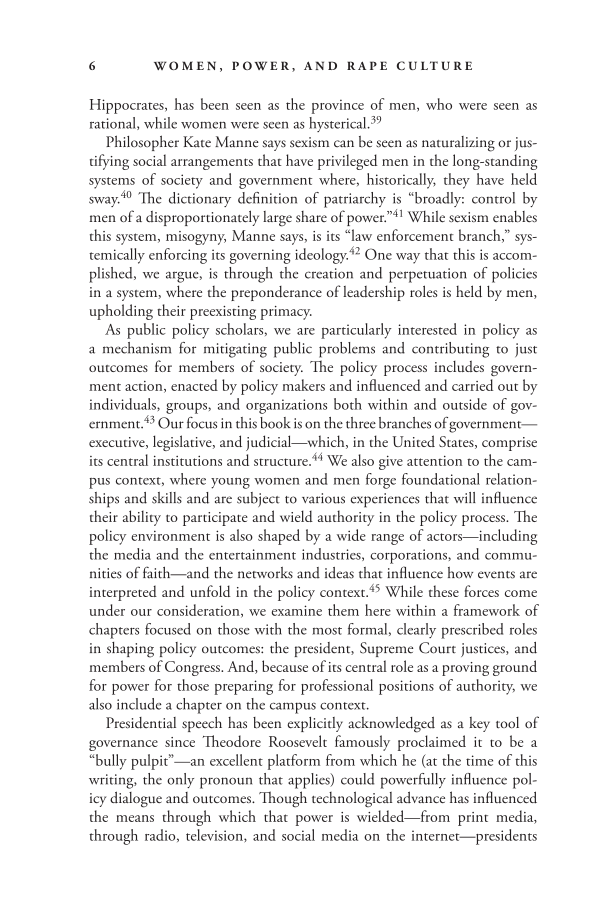W O M E N , P O W E R , A N D R A P E C U L T U R E 6 Hippocrates, has been seen as the province of men, who were seen as rational, while women were seen as hysterical.39 Philosopher Kate Manne says sexism can be seen as naturalizing or jus- tifying social arrangements that have privileged men in the long-standing systems of society and government where, historically, they have held sway.40 The dictionary definition of patriarchy is “broadly: control by men of a disproportionately large share of power.”41 While sexism enables this system, misogyny, Manne says, is its “law enforcement branch,” sys- temically enforcing its governing ideology.42 One way that this is accom- plished, we argue, is through the creation and perpetuation of policies in a system, where the preponderance of leadership roles is held by men, upholding their preexisting primacy. As public policy scholars, we are particularly interested in policy as a mechanism for mitigating public problems and contributing to just outcomes for members of society. The policy process includes govern- ment action, enacted by policy makers and influenced and carried out by individuals, groups, and organizations both within and outside of gov- ernment.43 Our focus in this book is on the three branches of government— executive, legislative, and judicial—which, in the United States, comprise its central institutions and structure.44 We also give attention to the cam- pus context, where young women and men forge foundational relation- ships and skills and are subject to various experiences that will influence their ability to participate and wield authority in the policy process. The policy environment is also shaped by a wide range of actors—including the media and the entertainment industries, corporations, and commu- nities of faith—and the networks and ideas that influence how events are interpreted and unfold in the policy context.45 While these forces come under our consideration, we examine them here within a framework of chapters focused on those with the most formal, clearly prescribed roles in shaping policy outcomes: the president, Supreme Court justices, and members of Congress. And, because of its central role as a proving ground for power for those preparing for professional positions of authority, we also include a chapter on the campus context. Presidential speech has been explicitly acknowledged as a key tool of governance since Theodore Roosevelt famously proclaimed it to be a “bully pulpit”—an excellent platform from which he (at the time of this writing, the only pronoun that applies) could powerfully influence pol- icy dialogue and outcomes. Though technological advance has influenced the means through which that power is wielded—from print media, through radio, television, and social media on the internet—presidents
Document Details My Account Print multiple pages
Print
You have printed 0 times in the last 24 hours.
Your print count will reset on at .
You may print 0 more time(s) before then.
You may print a maximum of 0 pages at a time.









































































































































































































































